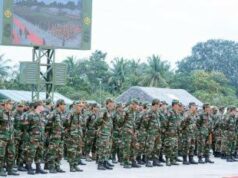Indian Armed Forces have been asking for dedicated satellites as a force multiplier exclusively for the use of the military since ages. The fledgling Army Special Forces had in fact officially projected for an exclusive transponder on one of the communications satellite right after its formation in 1993 itself.
By now it is an essential requirement due the fact had that Armed Forces are moving towards network-centric warfare on land, air and sea. All assets deployed all over in the three medium and soon in space also need to be connected through space technology.
Accordingly next month, the Indian Space Research Organisation,ISRO will be launching GSAT-7A an advanced communications satellite, dedicated to the Indian Air Force, IAF which will add more air power and give the service additional strategic communication capabilities. This GSAT-7A will be launched by the Indian rocket Geosynchronous Satellite Launch Vehicle (GSLV) from Sriharikota launch pad.
Ratan Shrivastava, Advisor, Space Division, FICCI, said that, “Designed and developed by ISRO the GSAT 7 is helpful in extending the range of operations of the IAF aircraft, specially designed to enable network centric warfare and surveillance capabilities of the air force by providing a platform for linking the aircraft with ground stations, radars and other surveillance and military communication systems. It is a secure mode and will be for exclusive use of IAF.”
The GSAT-7A will enable the IAF to interlink all ground radar stations, airbases and Airborne early warning and control aircrafts. The GSAT -7A payload has a switchable frequency plan for mobile users in Ku-band. It features one Gregorian reflector antenna and four steerable reflector antennas.
In Sept 2013, a satellite in the GSAT-7 series was launched for the Indian Navy, a a multi-band communication satellite making the navy totally capable of communicating with all its warships, submarines aircraft and land systems.
Despite the lack of a Comprehensive Space Policy, which is expected to be formulated by the HQ IDS, Department of Space, MoD and finally vetted by PMO soon, there are 13 satellites currently in use by the armed forces for surveillance.
We still have a long way to go.



